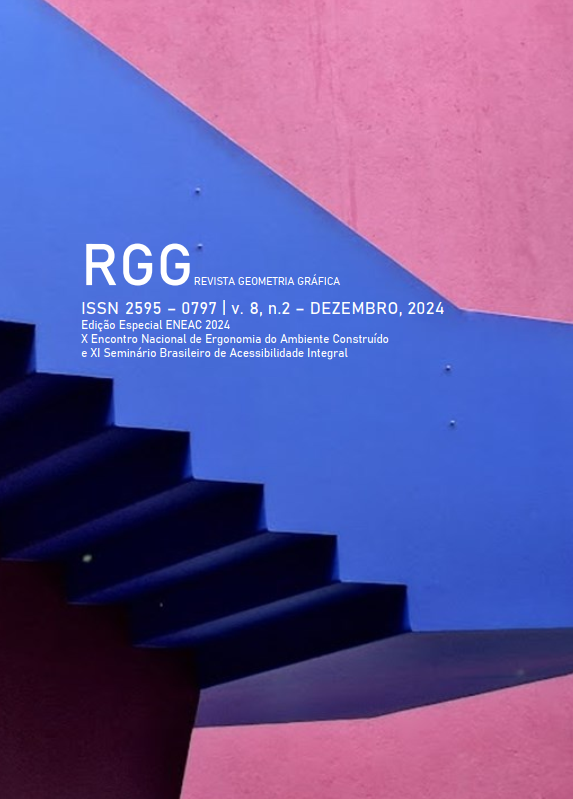Universal design in single-family housing
reflections on the design exercise
DOI:
https://doi.org/10.51359/2595-0797.2024.265289Keywords:
universal design, accessibility, architectural project, project teachingAbstract
In this article, reflections and results are presented about a didactic experience of a set of experiences carried out in an interdisciplinary way by the disciplines of Architectural Design II, Models and Universal Design. The objective of choosing the activity was to equip and sensitize students to the technical and social relevance of the topic, through awareness of social inclusion and promotion and reflection on the importance of space without physical and/or attitudinal barriers. Based on the active Problem Based Learning – PBL methodology, the studies reached varying results in deepening the proposals, but the results were considered satisfactory.
References
ASSOCIAÇÃO BRASILEIRA DE NORMAS TÉCNICAS (ABNT). NBR 9050: acessibilidade a edificações, mobiliário, espaços e equipamentos urbanos. Rio de Janeiro, 2020. Disponível em: https://www.caurn.gov.br/wp-content/uploads/2020/08/ABNT-NBR-9050-15- Acessibilidade-emenda-1_-03-08-2020.pdf. Acesso em: 27 mar. 2022.
BRASIL. Lei Federal nº 13.146, de 06 de julho de 2015. Institui a Lei Brasileira de Inclusão da Pessoa com Deficiência (Estatuto da Pessoa com Deficiência). Brasília, DF: Presidência da República. Disponível em: http://www.planalto.gov.br/ccivil_03/_ato2015- 2018/2015/lei/l13146.htm. Acesso em: 25 mar. 2024.
BRASIL. Decreto nº 9.451, de 26 de julho de 2018. Regulamenta o art. 58 da Lei nº 13.146, de 6 de julho de 2015, que institui a Lei Brasileira de Inclusão da Pessoa com Deficiência - Estatuto da Pessoa com Deficiência. Brasília, DF: Presidência da República. Disponível em: http://www.planalto.gov.br/ccivil_03/_Ato2015-2018/2018/Decreto/D9451.htm. Acesso em: 25 mar. 2024.
CONNELL, B. R. et al. Universal Design Principles: The Center for Universal Design Environments and Products for All People. Raleigh: NC State University, The Center for Universal Design, 1997.
DORNELES, Vanessa et al. Ensino de desenho universal em cursos de arquitetura e urbanismo no Brasil. In: Cláudia Mont’Alvão e Vilma Villarouco (Orgs.). Um novo olhar para o projeto: a ergonomia no ambiente construído – Recife: Editora UFPE, 2014. 247p.
FULGÊNCIO, Vinícius; VILLAROUCO, Vilma; A acessibilidade em projetos habitacionais de interesse social: uma experiência de ensino no curso técnico de edificações do IFBA – campus Feira de Santana, p. 164-175. In: Anais do 15º Ergodesign & Usihc. Blucher Design Proceedings, vol. 2, num. 1. São Paulo: Blucher, 2015.
GINGRICH, Paul. Critical Theory. Regina, Canadá: University of Regina, Department of Sociology and Social Studies, 2000. Disponível em: https://uregina.ca/~gingrich/m900.htm. Acesso em: 13 maio 2022.
GUIMARÃES, Marcelo Pinto. Writing poetry rather than structuring grammar: notes for the development of Universal Design in Brazil. In: PREISER, Wolfgang F. E.; SMITH, Korydon H. (org.). Universal Design Handbook. Nova Iorque: McGraw-Hill, 2011.
KOWALTOWSKI, Dóris et al. Arquitetura escolar e seu processo de projeto. In: Dóris C.C.K. Kowaltowski, Daniel de Carvalho Moreira, João R. D. Petreche, Mário M. Fabricio (Orgs.). O processo do projeto em arquitetura. São Paulo: Oficina de textos, 2011.
NIEMEYER, Oscar.1907 - Conversa de Arquiteto/ Oscar Niemeyer. - Rio de Janeiro: Revan, maio de 1999, 4ª. Edição.
SÃO PAULO (PREFEITURA). Secretaria da Habitação e Desenvolvimento Urbano. Comissão Permanente de Acessibilidade. Manual de Desenho Universal: habitação de interesse social. São Paulo, nd.
STEINFELD, E.; MAISEL, J. L. Universal Design Creating Inclusive Environments. Hoboken: John Wiley & Sons, Inc., 2012.
TUAN, Yi-Fu. Espaço e lugar: a perspectiva de experiência. Londrina, Paraná: Eduel, 2013.


